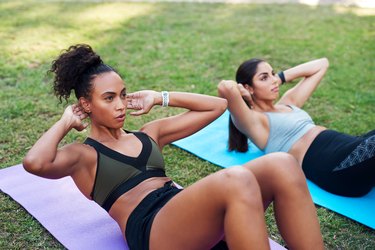
The classic sit-up is performed with a partner holding your feet or with your feet anchored under a brace as you lift your torso all the way up toward your thighs. This variation may be common, but it isn't necessarily the best way to train your core.
Anchored-feet sit-ups require more activation from your hip flexors than from your abdominal muscles, so you may not be working the muscles that you hope.
Video of the Day
Read on to learn how to do sit-ups correctly without anchoring your feet to get the best core workout.
- What is the proper way to do sit-ups? There's no one best sit-up variation, according to Carolina Araujo, CPT, a New York-based strength coach. But when you do the exercise without holding your feet down, you do get more core engagement.
- What muscles do sit-ups work? Sit-ups primarily work your core, including your rectus abdominis, transverse abdominis and obliques. You'll also get some strengthening in your hip flexors, too.
- Who can do sit-ups without an anchor? "Doing sit-ups without a foot anchor is a little more difficult, so it's probably not appropriate for beginners," Araujo says. Anyone with pre-existing injuries or who is pregnant should talk to a doctor before trying new exercises. Also, if you have trouble getting down onto the ground, swap for another core exercise.
How to Do Sit-Ups Without Anchoring Your Feet
- Lie on your back on an exercise mat. Bend your knees and plant your feet about hip-distance apart. Hold your arms straight out in front of your body.
- Exhale and engage your abdominal muscles by pulling your belly button in toward your spine.
- Keeping your core engaged, start to lift your shoulder blades and spine off the mat, leading with your arms. As you lift, keep your feet planted.
- Once you're fully sitting up, slowly reverse the motion back to the starting position to complete one sit-up.
Tip
Move slowly and deliberately. Only sit up as high as you can go while keeping your feet planted on the ground, Araujo says.
Common Unsupported Sit-Up Mistakes
Can't do a sit-up without anchoring your feet? Don't stress, you're actually doing more work for your abs with a partial sit-up or crunch.
Your abs activate most when you lift to between a 30- and 45-degree angle off the floor, according to the University of New Mexico. This is means getting your shoulder blades up off the floor, not sitting up completely.
Also, try to avoid rocking and rolling or thrusting your body to get all the way up in the sit-up. When you do this, you create momentum to help you perform the exercise, rather than using your muscles.
In order to do a proper sit-up with no anchor, avoid kicking your feet or scrambling with your arms.
Sit-Up Variations
1. Weighted Sit-Ups
- Lie on your back on an exercise mat. Bend your knees and plant your feet about hip-distance apart. Hold a dumbbell or medicine ball at your chest.
- Exhale and engage your abdominal muscles by pulling your belly button in toward your spine.
- Keeping your core engaged, start to lift your shoulder blades and spine off the mat, leading with your arms. As you lift, keep your feet planted.
- Once you're fully sitting up, slowly reverse the motion back to the starting position to complete one sit-up.
Tip
You can make your sit-ups more challenging by adding a weight, Araujo says. That's because your core has to work to lift your own body weight plus the additional load. Start with a lighter weight and slowly increase as you grow stronger.
2. Use a Decline Bench
- Lie on your back on a decline exercise bench. Bend your knees and plant your feet about hip-distance apart. Or, loop secure your feet into the bench.
- Exhale and engage your abdominal muscles by pulling your belly button in toward your spine.
- Keeping your core engaged, start to lift your shoulder blades and spine off the bench, leading with your arms.
- Once you're fully sitting up, slowly reverse the motion back to the starting position to complete one sit-up.
When you do push-ups on a decline bench you have a greater range of motion, according to Araujo. As a result, your core has to work harder in order to achieve a full sit-up.